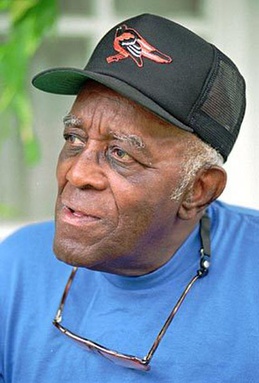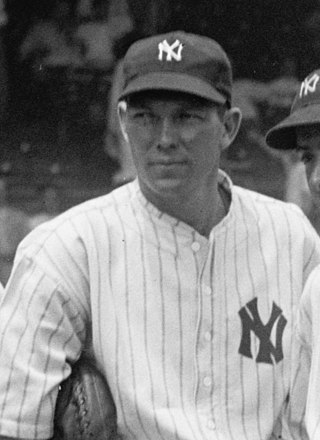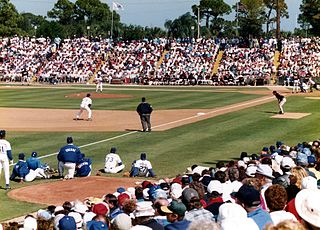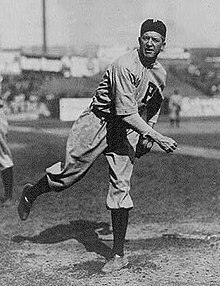
Hot Springs is a resort city in the state of Arkansas and the county seat of Garland County. The city is located in the Ouachita Mountains among the U.S. Interior Highlands, and is set among several natural hot springs for which the city is named. As of the 2020 United States Census, the city had a population of 37,930, making it the 11th most populous city in Arkansas.

Riverside Park, located in Dawson Springs, Kentucky, was originally built in 1914 to serve as a spring training park for the Pittsburgh Pirates from 1914 to 1917. Sometimes referred to as Tradewater Park, it is the only known baseball park in Kentucky to have hosted a major league team since the Louisville Colonels folded in 1899. While the original stadium was destroyed in a flood in the 1930s, it was later rebuilt in 1999. Like the original stadium, the rebuilt park is reconstructed out of wood. It is the only ballpark of its kind in Western Kentucky.

Oscar McKinley Charleston was an American center fielder and manager in Negro league baseball. Over his 43-year baseball career, Charleston played or managed with more than a dozen teams, including the Homestead Grays and the Pittsburgh Crawfords, Negro league baseball's leading teams in the 1930s. He also played nine winter seasons in Cuba and in numerous exhibition games against white major leaguers. He was inducted into the National Baseball Hall of Fame in 1976.

Leon Day was an American professional baseball pitcher who spent the majority of his career in the Negro leagues. Recognized as one of the most versatile athletes in the league during his prime, Day could play every position, with the exception of catcher, and often was the starting second baseman or center fielder when he was not on the mound. A right-handed pitcher with a trademark no wind-up delivery, Day excelled at striking batters out, especially with his high-speed fastball. At the same time, he was an above-average contact hitter, which, combined with his effectiveness as a baserunner and his tenacious fielding, helped cement Day as one of the most dynamic players of the era.

Joshua Gibson was an American baseball catcher primarily in the Negro leagues. Baseball historians consider Gibson among the best power hitters and catchers in baseball history. In 1972, he became the second Negro league player to be inducted in the National Baseball Hall of Fame.

William Hendrick Foster was an American left-handed pitcher in baseball's Negro leagues in the 1920s and 1930s, and had a career record of 110–56. He was elected to the Baseball Hall of Fame in 1996. Foster was the much-younger half-brother of Rube Foster, a Negro league player, pioneer, and fellow Hall of Famer.

William Malcolm Dickey was an American professional baseball catcher and manager. He played in Major League Baseball with the New York Yankees for 19 seasons. Dickey managed the Yankees as a player-manager in 1946 in his last season as a player.

Ernest Judson Wilson, nicknamed "Boojum", was an American third baseman, first baseman, and manager in Negro league baseball. He played for the Baltimore Black Sox, the Homestead Grays, and the Philadelphia Stars between 1922 and 1945. Wilson was known for possessing a unique physique, a quick temper, and outstanding hitting skills. One of the Negro leagues' most powerful hitters, his career batting average of .351 ranks him among the top five players.

The Baltimore Elite Giants were a professional baseball team that played in the Negro leagues from 1920 to 1950. The team was established by Thomas T. Wilson, in Nashville, Tennessee as the semi-pro Nashville Standard Giants on March 26, 1920. The team was renamed the Elite Giants in 1921, and moved to Baltimore, Maryland in 1938, where the team remained for the duration of their existence. The team and its fans pronounced the word "Elite" as "ee-light".

Cristóbal Torriente called Babe Ruth of Cuba , was a Cuban outfielder in Negro league baseball with multiple teams. He played from 1912 to 1932 and was primarily a pull hitter, though he could hit with power to all fields. He had a stocky and slightly bowlegged build, but was known for deceptive power and a strong, accurate arm from center field. Indianapolis ABC's manager C.I. Taylor stated, "If I see Torriente walking up the other side of the street, I would say, 'There walks a ballclub.'" Torriente was elected into the National Baseball Hall of Fame in 2006.
The following are the baseball events of the year 1961 throughout the world.
The following are the baseball events of the year 1935 throughout the world.
The following are the baseball events of the year 1921 throughout the world.

The Arkansas Alligator Farm and Petting Zoo is a privately owned zoo located on Whittington Avenue in Hot Springs, Arkansas.

Spring training is the preseason in Major League Baseball (MLB), a series of practices and exhibition games preceding the start of the regular season. Spring training allows new players to try out for roster and position spots, and gives established players practice time prior to competitive play. Spring training has always attracted fan attention, drawing crowds who travel to the warm climates of Arizona and Florida to enjoy the weather and watch their favorite teams play.

Ban Johnson Park was a baseball stadium located in Hot Springs, Arkansas. It was also known as Whittington Park and McKee Park. The ballpark was located within today's Whittington Park Historic District and directly across from the still active Arkansas Alligator Farm and Petting Zoo.
George McKinley Barr was an American professional baseball umpire who was a pioneer in umpiring instruction. Barr worked in the National League from 1931 to 1949. Barr umpired 2,757 major league games in his 19-year career. He umpired in four World Series and two All-Star Games. Barr was the founder of the George Barr Umpire School, the earliest umpire training school and author of the first book on umpiring. Barr was a pioneer in using the inside chest protector.
The original Majestic Park was one of the first Major League Baseball spring training facilities. The ballpark was located at the corner of Belding Street and Carson Street in Hot Springs, Arkansas. Today, the site is in use by Champion Christian College, National Park College, and travel/tournament baseball and softball. Majestic Park has been renovated by the City of Hot Springs. Babe Ruth, Cy Young, Jackie Robinson and Hank Aaron are among the many who have played at the site.
The Hot Springs Arlingtons were a professional Negro leagues baseball team based in Hot Springs, Arkansas from 1896 to 1904. The Hot Springs Arlingtons played as members of the Southern Negro League and hosted home games at Whittington Park. The team was known as the Hot Springs Blues in 1904.

Wearn Field was a ballpark located in Charlotte, North Carolina and home to amateur and professional baseball in Charlotte from 1912 to 1940. Wearn Field was built and owned by Hornets club owner J. H. Wearn alongside his lumber mill. Home plate was at the corner of South Graham and Winona Streets; the right field corner was at South Graham and Commerce.

















